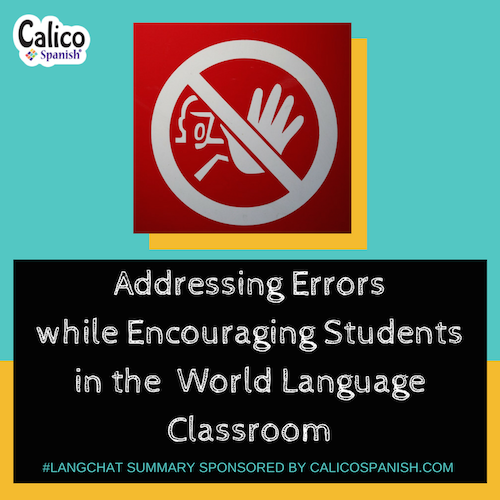Addressing Errors while Encouraging Students in the World Language Classroom
 Learning in general is often more successful with bold practice and a willingness to make mistakes. Overcorrection from teachers, however, can discourage learners. In the September 21 #Langchat, teachers discussed how to correct student output while still encouraging them to put forth effort.
Learning in general is often more successful with bold practice and a willingness to make mistakes. Overcorrection from teachers, however, can discourage learners. In the September 21 #Langchat, teachers discussed how to correct student output while still encouraging them to put forth effort.
– Follow the blog on Bloglovin –
Determining the Errors to Correct
It is sometimes difficult for #Langchat teachers to determine which language errors should be corrected. Because the affective filter (a learner’s general emotional attitude toward learning) is often high in a world language classroom, #Langchat teachers know that it is not always helpful to correct every mistake a student makes. What constitutes output worth correcting? @SraWilliams3 said, “the longer I’ve taught, the less I feel the need to correct output. I only [correct] if I can’t understand at all.” Corrections should be made “when the error changes the meaning of what they were trying to say,” according to @SraStephanie. @MmeJGillespie shared, “it depends on the student. Some are shy and I don’t want to discourage their attempts to speak. [Instead], I usually rephrase what’s said.”
Addressing errors without resorting to the native language
Staying in the target language can be tricky when correcting student output. There are a variety of ways to correct while remaining in the target language. @SraMarconi260 shared that she stays in the target language “by rephrasing the questions and modeling the correct pronunciation for the students to follow.” @Profedenham said, “It’s back to modeling with gestures. Also, use visuals, I have word and verb walls all over my room. Pointing works too.” @PRHSspanish shared, “I stopped recasting last year so much and experimented with framing it in the perspective of their response. ‘¿Me gusta?’” Of course, “accuracy comes from lots of ACCURATE comprehensible input, with opportunities for output with real feedback” (@KrisClimer).
– Like Calico Spanish on Facebook –
Correcting Errors Based on Levels
#Langchat participants shared how they vary the way in which they correct errors based on the level that they are teaching. For @jaybeekay518, “lower levels get written and spoken reframing to reinforce nuances both ways–upper levels get verbal negotiation of meaning.” Elementary Spanish teacher @MundodePepita shared, “with my Kindergarteners I rarely correct directly; by 4th grade we are refining more directly when appropriate. Communication is key.” Some #langchat teachers find that there should not be any differences for correcting errors based on a student’s level. For example, @jnowak_asl said, “I don’t think it looks different from level to level. I ask them to try their best and I help them be the best they can be.” @LauraErinParker also shared, “I don’t think my approach to feedback changes – just the proficiency that students have reached changes.”
Introduce a child you love to a lifelong journey of speaking real Spanish to real people. Click the red button to experience it FREE.
Different ways to Correct Output
There are many ways to correct errors in output without bringing discouragement into the classroom.
- @SraWilliams3 said, “I think circling* has been a gem to help with corrections. REPEAT REPEAT REPEAT.” *circling: a TPRS technique in which a teacher asks questions involving very similar information but changing one or two details, e.g. “Who went to the store?” followed by “Did the boy go to the store?”
- @SraDentlinger shared, “if I’m working on a reading, I bold or underline concepts we’re working with to remind them.”
- @SraMcNeilly said, “have students self-evaluate proficiency skills and choose their own practice for improvement.”
- @Oraib_Mango encourages through “a lot of listening and reading and repetition with different activities.”
– Follow Calico Spanish on Twitter –
Framing Feedback
After mistakes and errors are made, #Langchat teachers find it important to encourage students to try again. “Celebrate success, choose 1-2 things that could help them move up proficiency wise” (@SraWilliams3). @jnowak_asl said, “I make my errors obvious to them to try to show everyone makes mistakes. I don’t expect perfection, just their best effort.” Go beyond the feedback on errors. @Srta_Zeiner said, “provide students the opportunity to use the feedback to revise and resubmit. Don’t let your corrections be the be-all end-all.” @MundodePepita, explained that “our tone, facial expressions, and body language are key to making our students feel we are helping them, even when we need to correct.” Finally, it is important to remember to “lay the groundwork. Show kids you care about them and their learning way before corrections” (@SraStephanie).
– Follow us on Instagram too! –
Thank You
Is there a topic you would like to discuss in the coming weeks? Check out our #Langchat wiki and tell us your ideas! Thank you so much to all those who participated in the #Langchat on Addressing Errors while Encouraging Students in the World Language Classroom. Thank you to our lead moderator, Elizabeth (@SraDentlinger), for her hard work and contributions!






No Comments